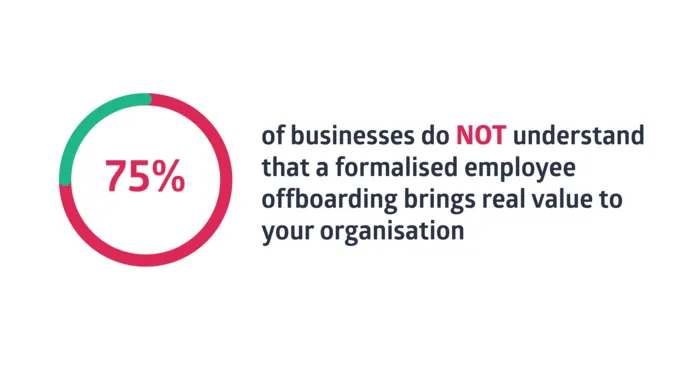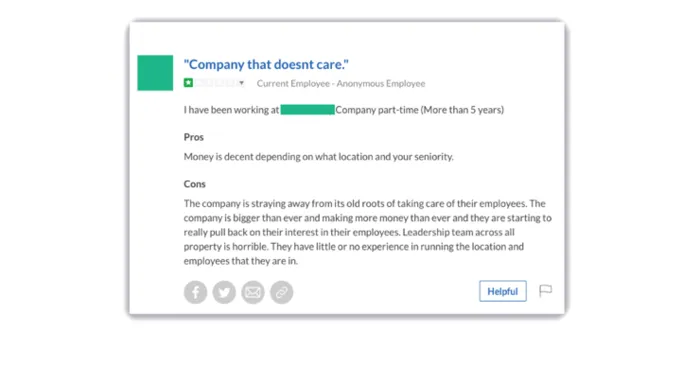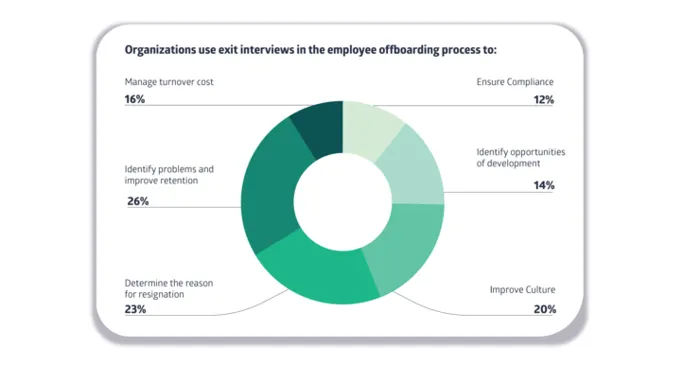Employee Offboarding: How to Boost Your Branding

In today’s post, we’re going to talk about the steps you need to take to ensure an ‘amicable’ break-up with your exiting employees. This is done through a process called employee offboarding, and you must get it right.
If you’re treating employee offboarding as an afterthought, you’re most likely hurting your employer branding efforts.
Regardless of their reason for leaving (termination or voluntary departure), you can bet those ex-employees will have something to say about your organization. Whether that something is good or bad largely depends on how they remember their last few days.
Bad breakups are the worst, aren’t they? You sit there, stunned, flicking through the images in your mind, trying to tally all the real (and imagined) grievances while downing your fifth beer. And then you meet up with your friends, and you let it all out…
Well, this probably won’t come as a surprise, but your ex-employees also talk. They tell their side of the story and share their work experiences. And what they say has an impact on how job seekers perceive your organization.
What’s worse, ex-employees often go to social media and business review sites to vent. With a single post, they can invalidate years of hard work that you’ve put into building a recognizable employer brand.
What is employee offboarding?
Employee offboarding is a process during which an employee exits an organization. It’s everything that goes (or doesn’t go) into their official departure from their role. Now, if you don’t have a formalized employee offboarding process, you might be under the impression that you ‘don’t actually do offboarding.’
That’s not true. Employee offboarding happens whether or not you’ve taken the time to spell it out and codify it (just like employee onboarding).
Only when you don’t codify it, it generally happens in a way that's bad for you.
The purpose of an employee offboarding process is twofold:
- It helps an organization improve its hiring practices and employee experience to keep existing (and future) employees engaged, productive and committed
- It allows an organization to leave a memorable positive impact on the exiting employee, which can benefit the organization’s employer brand and image.
A formalized employee offboarding process brings real value to your organization. Unfortunately, even though some businesses see that, according to a study by Aberdeen Group, almost 75% don’t. And you definitely don’t want to side with the majority in this particular case.

The connection between employee offboarding and employer branding
Imagine dealing with a top-performing employee who’s just told you they’ll be leaving in 30 days.
You thank them for the notice, instruct them to consult with their manager to hand off their duties, and then you promptly forget about the whole thing.
But…
Now they’re growing resentful.
You didn’t ask why. You didn’t try to understand their reasons. You didn’t make an effort.
You see… where you had a valuable member of the organization that you might have been able to persuade to stick around, you now have a disgruntled, soon-to-be-former, employee.
This could have been avoided with a formalized offboarding process, where you would get insights you need to tweak your retention and hiring practices, and they (and their colleagues) would know how things play out during the next month.
There’s a chance now that this (previously satisfied) employee goes out and tells the world how badly they’ve been treated. We both know they weren’t — but their last (and memorable) experience in your organization didn’t leave a good taste in their mouth.
So they fire off a particularly scathing review on Glassdoor.

And that’s a relatively satisfied employee, one who went out on their own terms.
Imagine if that were someone you had to terminate? What kind of story would they have to tell? And what kind of damage could they do to your employer branding efforts?
4 extra reasons to focus on employee offboarding
I understand the mental groan that escapes you when you read about stuff that results in more workload.
You’re busy…You don’t want to add things to the pile.
But, because employee offboarding is critically important, I want to share four more reasons you’ll benefit if you decide to do it the right way.
✔ Boomerang employees are a thing — let’s go back to the relationship analogy: the same way divorced couples sometimes get remarried, so employees and organizations occasionally reconnect. Especially in highly-specialized industries. This is good for you as it means less training, fewer costs, and increased productivity. But…That offboarding experience needs to be on-point if you want to keep that particular door open.
✔ Happy (ex) employees are valuable ambassadors — your ex-employees are networking with people you might want to attract. This is especially true if you’re in a very specialized niche (or they are). So make that last impression work for you — ensure that people recommend your organization instead of warning others about it.
✔ They can even become customers at one point — or they already are, depending on your line of work. Are you ready to lose a customer? Especially one that could have been your loudest, most fervent customer advocate? No? Then make sure to part ways respectfully and amicably.
✔ Every loose ex-employee is a security risk — a survey conducted by Druva found that 13% of organizations are aware of the fact that ex-employees still have access to their data. Now, I’m not saying that yours is one of those organisations — but are you 100% sure that you’ve deprovisioned everyone who’s ever walked out or been terminated? Especially if that’s not outlined in your (often non-existent) employee offboarding process.
Here are our recommended 9 steps to offboard an employee:
1. Create a quick and rough offboarding checklist
Here are some things you should include in your checklist, so you’re reminded about them:
- Reason for leaving (voluntary or termination). Tailor the experience to the reason, and brace for dealing with some unpleasantries if we’re talking about termination.
- Get a resignation notice (or prepare a termination notice). Write this down, sign it, and have the employee sign it as well (give them their copy).
- Schedule an appointment to iron out the details of their exit. When, how, will their support be expected, who is best suited to take over their duties, etc.).
- Inform other departments about the exit (IT and payroll). Get input from them on what needs to be handled (access, accrued leave, backpay, company credit cards, etc.).
- Review signed agreements. Non-disclosure, non-compete, confidentiality, etc. And make sure you’re on the same page.
- Take care of the final paycheck. If possible, release it early. The employee will appreciate it, and you can immediately scrub them from the payroll list (without risking that you’ll forget about that down the road).
2. Say ‘thank you’ early and often
Even when fired in awful circumstances, employees like to hear a “thank you” in relation to their work so far. It’s such a game-changer when a manager acknowledges someone’s contributions. And it’s what makes a difference between a good manager and a great manager. In fact, praise is the most effective way to motivate people:

3. Communicate the exit
When someone’s leaving, you don’t want the office grapevine to take over. Your employees will fill in the gaps they don’t know, and in a second, rumors can turn a voluntary departure into a violent termination.
Avoid that by telling people why someone is leaving, what’s going to happen in the meantime, and then end on a positive note.
4. Celebrate the employee’s achievements
There are some rare circumstances when celebrating an ex-employee is not possible (they’ve been fired for gross misconduct, inappropriate behavior, theft, or similar).
In all other cases, make a conscious effort to make them feel good about their time in your organization. Email the employee’s team, organize an impromptu office party, and surprise them with a farewell present. Schedule this close to their last day in the office so the memory stays fresh in their mind.
5. Transfer duties and knowledge
One of the key elements of every employee offboarding process is setting up a reliable routine for knowledge and duties transfer. This routine will vary from position to position, but you want it to include things like:
- How does their day-to-day look? What’s the most effective way for a person taking over to complete their daily tasks? What systems, files, and tools are crucial for the new employee to get familiar with?
- Key stakeholders for the role. Identify the most important people that are crucial for the role, and make introductions early in the transfer process.
- In collaboration with the exiting employee, create videos using Loom, for example, that will guide new hires through more complicated tasks (add these to your onboarding/training database)
- See if some things can be automated. That way, things don’t grind to a halt while you’re training a new hire.
6. Revoke access and recover assets
Set up a meeting with the IT and finance department to go through everything company-related that the exiting employee is still using, such as server-side tools, cloud systems, paid ongoing trainings. But don’t also forget to revoke access to social media platforms if the employee is someone from marketing or comms.
You’ll want to cover things like the company car, company laptop and smartphone, credit cards, and uniforms when it comes to assets.
7. Conduct an exit interview
This is likely the essential step in the employee offboarding process — provided you ask the right questions and know what to do with the answers you collect.
An exit interview allows you to home in on the why of the departure. In the end, you’re left with a list of strengths and weaknesses you’ll want to take a look at to increase your retention rates.

Here are some questions that you should ask:
-
What (if anything) would you change about your role?
-
What are we not doing right (and how can we improve on that)?
-
If we could do one thing to make you stay, what would that be?
-
Is there a manager in the company that you really admire?
-
What’s the one thing you looked forward to when coming to work?
-
What was the least fun thing about the organization?
-
How could your relationship with your manager have been improved?
-
Would you recommend the company to your friends and peers?
-
Is there anything you would change about our onboarding process?
-
Is there anything you would change about our employee offboarding process?
8. Be helpful and offer resources
For the most part, organizations wrap things up after conducting exit interviews. But what if you didn’t end your relationship there? What if you offered additional resources to your ex-employees, regardless of whether they’ve been terminated or they’re leaving voluntarily?
You could also give them a glowing reference letter, include them in your database if a role comes up they would be more suited for (or prefer working in). Recommend them to your own network of peers and collaborators. These are all options that are low-cost, high-impact. And ex-employees will appreciate them.
In some cases, you can even go above and beyond and offer additional training to those people you’re reluctantly letting go of. For example, you can organize workshops in writing or social media management for marketing employees. An expert workshop cost is in the low $1000s, so you’re not spending too much. And the employees are getting a marketable new skill and another reason to feel good about their time in your organization.
9. Stay in touch
Talk to your marketing team and set up a segmented list of ex-employees. It’s small. It’s vetted. And it’s not labor-intensive. But it allows you to stay in touch and share company news from time to time.
With this minimal investment, you get to:
-
Easily connect and disseminate promotional info
-
Access employees, you might have some questions for the future
-
Promote your open positions to a pool of qualified candidates.
Alternatively, you can set up an alumni group on Slack for those ex-employees that want to stay in closer contact with their former team members. Those who opt for this are signaling that they might not be too hard to lure back if a better opportunity presents itself.
An efficient employee offboarding process for the win
With onboarding, you get a few shots. If the employee is not settling in, you can try a couple of different tactics. Heck, you put existing employees through an onboarding session years after they’ve been hired — it’s a chance to retrain them in certain aspects of their job description.
But offboarding is different. You only get one shot. And you want to make sure you nail it because that particular ex-employee could become an important asset. They could become a trusted partner. Or a huge customer. Or your most vocal advocate.
To increase the chances of that happening, use employee offboarding to strengthen and protect your employer brand. It’s a simple, straightforward process that keeps on giving!